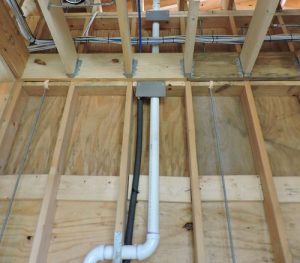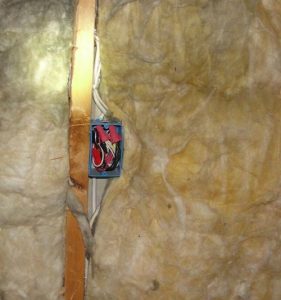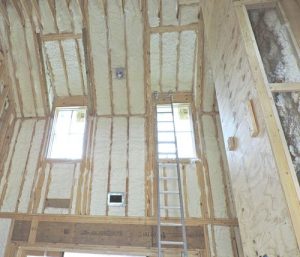15 Sep September 2021: Insulation Choices


Office: 843 846 2500
www.WillisSinclair.com
Info@WillisSinclair.com
Excellent Quality. Exceptional Service.
September 2021
Number 91

Greetings from Kandie (left), Jane and George on Jekyll Island! Willis and his family took a deserved, long weekend there to celebrate their 19th anniversary. Abbey went along to watch the younger ones.
 From the Desk of Bill
From the Desk of Bill
We are 2/3 of the way through 2021. The time has seemed to go quickly. Maybe that is because I am older or maybe it is just what seems to happen.
Even with the labor shortages and other challenges, we are staying busy building and remodeling homes for our clients.
We are very grateful for your support and trust. We will never knowingly disappoint you. Sometimes, we have to really scramble because of shortages (labor or material or both), but we will not cut corners or do a less than excellent job.
On a personal note, I am continuing to enjoy my “retirement” although it seems I am as busy as I was when I was working full time on site. I am still writing letters weekly to 23 of our grandchildren and most of our children who live out of the area. Occasionally, I help with various tasks for the company from repairing trucks to pricing new projects. In addition, I write this newsletter monthly. I also have a few home remodel projects in the works here. Kandy and I have been able to take several trips to visit out of town (Knoxville, Tennessee and Springfield, Missouri areas) children.
We will be celebrating our 53rd anniversary in a few days (September 6). A couple of months later I will be celebrating my 75th birthday. To celebrate, I think we will take a short vacation to the upstate somewhere. The cool mountain air would be nice to experience. We have stayed in several bed & breakfasts in the northern part of the state and enjoyed them. There are also a number of beautiful state parks along State Road 11 in the northwestern part of the state.
Recently, many of us attended an “Audit the Vote Rally” in Beaufort. I still find it unbelievable that our American election process could have been compromised, but there is certainly a lot of evidence to support that idea. Am I watching the take over of my country? Whether 2020 was a corrupted election or not, we really need legitimate audits to put the question to rest. It is not about who won or lost. It is not about political parties or persuasions. It is about the future of our nation under God. If our votes don’t count, we are in big trouble.
I cannot help but wonder why there is so much resistance to auditing the vote? Do those resisting know something they don’t want us to know? I would encourage legitimate audits of the process if I were running the elections. Why don’t our election officials and politicians (including the media) want audits? If our votes do not count fairly, the idea of a republic is gone.
When asked what sort of government the Continental Congress had established, Ben Franklin reportedly said something like, “A republic, if you can keep it.” I pray we keep it.
I believe we live in the greatest nation in the history of the world. America is a country where, if you work hard, you can accomplish amazing things. It is truly a land of opportunity. We cannot let that vanish. God blesses us — far more than we deserve.
Did you notice when hurricane Ida landed on the Gulf coast there was little warning — only a few days — that it would be a major hurricane. Are you prepared for a possible hurricane? Call us (843 846 2500). We can help. Don’t wait until the last day.
Insulation Choices
Insulate: to separate with a material that reduces the transfer of energy (heat and sound, in this case).
Typically, when you hear the word insulation in home building, you probably think about a material that reduces the flow of heat energy into (in the summer) or out of (in the winter) a home. There are many types of insulation and technically any material is an insulator; some very good insulators and some very poor insulators.
Thermal insulation is rated by an “R” number which stands for a resistance to heat flow. The higher the number the more resistance to thermal energy transfer (thus the better the insulation). Some insulating materials are much better than others, thus they have a higher R rating. The rating for 3½” thick fiberglass is R-13; for 5½”, R-19. Plywood sheathing (½”) has an R-0.63 rating which is much less than 5½” fiberglass.
The reason insulation is rated in a resistance to heat flow rather than simply heat flow is so the total insulating quality may be easily calculated. You simply add the R ratings. For example on a house with a sheet rock interior (R = 0.45), 2×6 walls with fiberglass insulation (R = 19), 1/2″ plywood sheathing (R = 0.63) and 4″ thick brick (R = 0.44), the total wall rating would be R = 20.52. This calculation does ignore the R ratings of the wall studs and assumes the insulation is perfectly installed with no voids or gaps so it is basically a “best case” number. It also assumes no air infiltration (around exterior electrical outlets, for example.)
Probably the most common insulation is fiberglass. This insulation is made of many tiny strands of glass that are loosely bonded. Since glass is a relatively poor insulator, you might wonder how fiberglass could be a good insulator. The answer is that it is not the glass that provides the insulation, but the tiny pockets of air trapped in the loose fiberglass that provide the insulation.
|
Fiberglass insulation is an economical way to insulate your home. It works well when wall cavities do not contain plumbing, electrical, HVAC or tie down rods. This exterior wall has tie down rods (for hurricane protection), plumbing and HVAC lines which complicates the installation of fiberglass batts.
|
Notice the gaps in insulation above and below this electrical box. These nearly unavoidable gaps are a downside for fiberglass insulation. Insulating around pipes or other objects in the wall is difficult and likely to leave voids.
|
Although it might seem counter intuitive, if you put R-19 fiberglass insulation in a 3½” cavity (2×4 studs) instead of a 5½” cavity, the R rating is not R-19. It is not even R-13. It performs worse than R-13 insulation because it is compressed and thus has less air trapped for insulating. For the insulation to perform as intended, it must be allowed to expand to its rated thickness.
Windows are “insulated” by using two or three panes of glass with air (or argon, an inert, clear gas) between the panes. You can observe how poor an insulator glass is by simply touching a window in your automobile on a hot day. A typical single pane of window glass has an R-0.9 rating. It is better than plywood, but usually plywood walls have insulation inside them. The R rating of glass is a bit deceptive also because glass allows light to pass through it and that causes heat. If you get in your automobile on a bright summer day, it will be toasty warm inside.
When you are calculating the total insulation effectivity, you simply add the R ratings. A 2×6 wall with fiberglass insulation, ½” plywood sheathing and a ½” sheet rock interior would be R-20.52. A double pane (insulated) window has an R rating of about R-1.6, much less than a wall. Large windows are nice for views and letting light in, but they are not so good for insulating.
You can see a list of common building materials and their R ratings here:
Fiberglass insulation also has the advantage that it will not burn if there is a fire. The insulation slows the air flow to burning materials, so it helps avoid the chimney effect. Nor will it give off toxic fumes.
Fiberglass insulation also resists the flow of acoustic (sound) energy. Frequently, it is used in the walls of rooms to block sound such as bedrooms or bathrooms.
|
I remember when I was a boy, I worked at a restaurant that burned to the ground. It was a large restaurant in the St. Louis area. One of the rooms in the restaurant had fiberglass curtains on the windows. When I was poking around the burned out building, I was a bit surprised to see the curtains lying on ashes. The curtains looked fine — a little sooty, but basically undamaged. Perhaps the fire was not that hot in the room with the curtains, but everything else was certainly burned. Fiberglass is an amazing material.
|
If fiberglass insulation is relatively inexpensive, efficient, fireproof and quick to install, you might wonder why there are other types of insulation. There are several reasons. Probably the largest disadvantage of fiberglass is that is it not always easy to install uniformly, particularly in walls that contain tie down rods, plumbing or electrical wiring. If the insulation does not fill the wall cavity, energy can easily flow through the voids spoiling the R rating.
Another reason is that sometimes, the fiberglass insulation in wall cavities may sag, again leaving voids. Fiberglass insulation used for for thermal purposes is bonded to kraft paper which is stapled to the studs. If staples tear out of the kraft paper, there is little to hold the insulation. Since the fiberglass insulation is not impervious to air flow, any openings such as around exterior electrical outlets or any air leaks will again diminish the R rating.
Another reason is that sometimes, the fiberglass insulation in wall cavities may sag, again leaving voids. Fiberglass insulation used for for thermal purposes is bonded to kraft paper which is stapled to the studs. If staples tear out of the kraft paper, there is little to hold the insulation. Since the fiberglass insulation is not impervious to air flow, any openings such as around exterior electrical outlets or any air leaks will again diminish the R rating.
|
Spray in foam insulation neatly fills the wall and roof cavities. It provides both thermal and acoustic insulation. Notice how well it fills in behind the can light and HVAC outlet.
|
Spray foam insulation is a popular alternative to fiberglass insulation. Usually, this is a polyurethane foam that can be either open cell or closed cell. Since the insulation is sprayed into wall cavities, it will easily flow around wires, tie down rods and plumbing leaving no voids. It will also seal any penetrations in the outer wall. The R rating of open cell insulation is about the same as fiberglass (R-3.7 per inch of thickness).
Closed cell insulation is more energy efficient as open cell (R-6 vs. R-8 per inch), is impervious to moisture. Open cell will allow moisture to pass. Closed cell also tends to help “glue” members (joists to subfloor, for example) together. This aids in eliminating creaking in joints. One downside of closed cell insulation is the price. Another is accessing items inside the stud bays (wires, plumbing, etc.) is difficult. Usually, closed cell insulation is used under floors and open cell is used in wall and roof applications.
Another real advantage of foam insulation is that it can be sprayed between the rafters in a roof. That means the attic is basically conditioned and remains quite comfortable temperature wise. With fiberglass insulation in the ceiling, attic temperatures frequently get well over 100 degrees in the summer. Since HVAC units or ducting are often in the attic, insulating the roof reduces the heat load on the HVAC system.
Like fiberglass, foam insulation also provides sound insulation.
Foam insulation does have disadvantages as everything does. First is cost. It is significantly more expensive than fiberglass. Spray in foam also will burn or release toxic fumes during a fire. Thus, code requires a flameproof coating over the foam in specified locations of the home.
In a home insulated with fiberglass, the rafters and roof sheathing is exposed, so if there is a leak, the location is usually obvious. If the roof cavities are filled with spray in foam, rain from a leak may flow along the insulation for a good distance before it leaks out. That means, if you have wet insulation, you have to start digging in the foam to try to find the leak. The same issue exists in the floor insulation. Leaks may not be close to where the water shows on the insulation.
One approach to the floor insulation is to insulate the foundation walls with spray foam and thus condition the crawlspace much as the attic is conditioned with foam in the roof. Not only does this leave the pipes and wiring exposed under the floor, it usually takes less foam (thus less cost) than spraying the entire floor system.
Which material is better? Probably the foam. It not only insulates, but seals voids. It stays in place. It is more expensive initially, but it will likely save you money in the long term.
Do you have questions? Call us 843 846 2500 (voice or text). We can help you make a wise decision about insulation.
| Next month, we will review geothermal options you may have for your home. |








No Comments